American Legion
The American Legion, commonly known as the Legion, is an organization of U.S. war veterans headquartered in Indianapolis, Indiana. It is made up of state, U.S. territory, and overseas departments, and these are in turn made up of local posts. The organization was formed on March 15, 1919, in Paris, France, by a thousand officers and men of the American Expeditionary Forces (A. E. F.) ,[1] and it was chartered on September 16, 1919, by the United States Congress.[2]
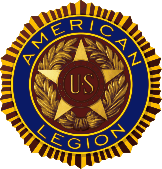 Emblem | |
 | |
| Motto | "For God and Country" |
|---|---|
| Established | March 15, 1919 |
| Founded at | Paris, France |
| Type | 501(c)(19), war veterans' organization |
| 35-0144250 | |
| Headquarters | 700 North Pennsylvania Street, Indianapolis, Indiana |
| Coordinates | 39.7770°N 86.1562°W |
Area served | Worldwide |
Membership (2018) | ~1,800,000 |
| James W. Oxford (NC) Since August 29, 2019 | |
National Executive Committee | 61 voting members
|
Key people |
|
Main organ | National Convention |
| Subsidiaries |
|
| Secessions | Forty and Eight |
| Website | legion |
The Legion played the leading role in the drafting and passing of the Servicemen's Readjustment Act of 1944, commonly known as the "G.I. Bill." In addition to organizing commemorative events, members provide assistance at Department of Veterans Affairs (VA) hospitals and clinics. It is active in issue-oriented U.S. politics. Its primary political activity is lobbying on behalf of interests of veterans and service members, including support for benefits such as pensions and the Veterans Health Administration.[3] It has also historically promoted Americanism, individual obligation to the community, state, and nation; peace and good will.[4]
History
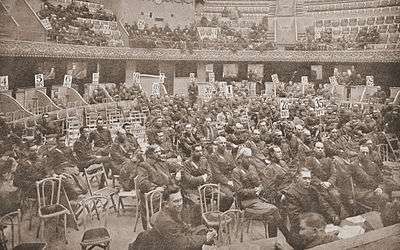
The American Legion was established in Paris, France, March 15, 1919, by a thousand officers and men, delegates from all the units of the American Expeditionary Forces (A. E. F.) to an organization caucus meeting, which adopted a tentative constitution. The action of the Paris meeting was confirmed and endorsed by a similar meeting held in St. Louis, May 8 to 10, 1919, when the Legion was formally recognized by the troops who served in the United States. The Paris caucus appointed an Executive Committee of seventeen officers and men to represent the troops in France in the conduct of the Legion. The St. Louis caucus appointed a similar Committee of Seventeen. These two national executive committees amalgamated and were the initial governing body of the Legion. The temporary headquarters was located in New York.[5]
List of founding members
The men who initiated the formation of the Legion:[6]
- Lt. Col. Theodore Roosevelt, Jr., of the First Division
- Col. Henry D. Lindsley, formerly Mayor of Dallas, Texas
- Sgt. John J. Sullivan, of Seattle
- Lt. Col. Franklin D'Olier, of Philadelphia
- Ex-Senator Luke Lea, of Tennessee
- Lt. Col. Frederick Huidekoper, of Washington, D.C.
- Major Redmond C. Stewart, of Baltimore
- Wagoner Dale Shaw, of Iowa
- Lt. Col. George A. White, of Oregon
- "Bill" Donovan, of the "Fighting 69th"
- Major Thomas R. Gowenlock, of Illinois
- Lt. Earl B. Dickerson, of the 92nd Division
- Sgt. Alvin C. York, of Tennessee
- Col. John Price Jackson, of the S. O. S.
- Lt. Col. "Jack" Greenway, of Arizona
- Sgt. Roy C. Haines, of Maine
- G. Edward Buxton, Jr., of Rhode Island
- Eric Fisher Wood, of Pennsylvania
- Chaplain John W. Inzer, of Alabama
- Lt. Col. David M. Goodrich, of Akron
- Chief Petty Officer B. J. Goldberg, of Chicago
- "Tom" Miller, of Delaware
- Major Alex. Laughlin, Jr., of Pittsburgh
- Major Henry Leonard, of the Marine Corps
- Dwight F. Davis, of the 35th Division
- Corporal Charles S. Pew, of Montana
- Brig. Gen. William G. Price, of the 28th Division
- Bishop Charles H. Brent, Senior Chaplain of the A. E. F.
- Maj. Gen. John F. O'Ryan, of the 27th Division
- Stewart Edward White, of California
- Private Jesus M. Baca, of New Mexico
- Brig. Gen. Charles H. Cole, of the 26th Division
- Sgt. E. L. Malsbary, of Nevada
- Lt. Samuel Gompers, Jr., of New York
- Col. Henry L. Stimson, Ex-Secretary of War
- Lt. Col. Charles W. Whittlesey, Commander of the "Lost Battalion"
- Roy Hoffman, of Oklahoma
- Lt. Col. A. Piatt Andrew, of the American Ambulance in France
- Brig. Gen. Harvey J. Moss, of the State of Washington
- John MacVicar, Mayor of Des Moines before the War
- Sgt. George H. H. Pratt, of New Orleans
- Col. F. C. Galbraith, of Cincinnati
- Corporal Joseph H. Fountain, of Vermont
- Devereux Milburn, of the 78th Division
- Lt. Col. Wilbur Smith, of the 89th Division
- Sgt. Theodore Myers, of Pennsylvania
- Col. Bennett C. Clark, son of Champ Clark
- Robert Bacon, Ex-Secretary of State
Headquarters

The national headquarters, informally known as American Legion headquarters, is located on the Indiana World War Memorial Plaza at 700 North Pennsylvania Street, Indianapolis, Indiana. It is the headquarters for the National Commander of The American Legion and also houses the Legion's archives, library, Membership, Internal Affairs, Public Relations, and The American Legion magazine's editorial offices. The headquarters has since experienced multiple expansions since its establishment.[7]
Eligibility
Membership in the Legion was originally restricted to U.S. soldiers, sailors and marines who served honorably between April 6, 1917, and November 11, 1918.[8] Eligibility has since been expanded to include military personnel who served on active duty in the Armed Forces of the United States, or armed forces associated with the U.S.,[9] between December 7, 1941, through a date of cessation of hostilities as determined by the United States Congress, and was a U.S. citizen when they entered that service or continues to serve honorably.[10] U.S. Merchant marines who served between December 7, 1941, and December 31, 1946, are also eligible.[11]
Publication
The organization's official publication in its initial phase was a magazine called The American Legion Weekly, launched on July 4, 1919.[12] This publication switched its frequency and renamed itself The American Legion Monthly in 1926.[13] In 1936 the publication's name and volume numbering system changed again, this time to The American Legion.[14]
Notable members
Notable members of The American Legion have included:[15][16][17]
.jpg) Harry Truman, 33rd President of the United States
Harry Truman, 33rd President of the United States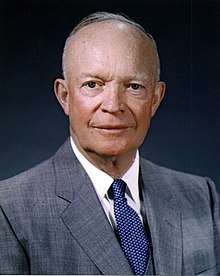 Dwight Eisenhower, 34th President of the United States
Dwight Eisenhower, 34th President of the United States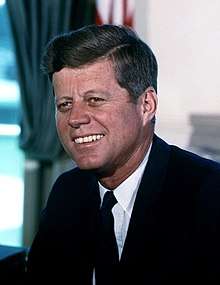 John Kennedy, 35th President of the United States
John Kennedy, 35th President of the United States Lyndon Johnson, 36th President of the United States
Lyndon Johnson, 36th President of the United States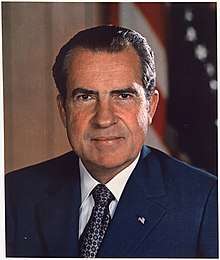 Richard Nixon, 37th President of the United States
Richard Nixon, 37th President of the United States.jpg) Gerald Ford, 38th President of the United States
Gerald Ford, 38th President of the United States Jimmy Carter, 39th President of the United States
Jimmy Carter, 39th President of the United States Ronald Reagan, 40th President of the United States
Ronald Reagan, 40th President of the United States.jpg) George Bush, 41st President of the United States
George Bush, 41st President of the United States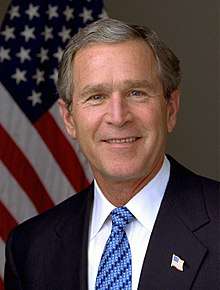 George Bush, 43rd President of the United States
George Bush, 43rd President of the United States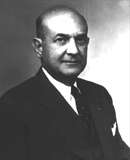 Louis Johnson, 2nd United States Secretary of Defense
Louis Johnson, 2nd United States Secretary of Defense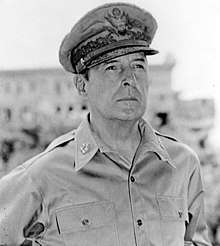 General of the Army Douglas MacArthur, Medal of Honor recipient
General of the Army Douglas MacArthur, Medal of Honor recipient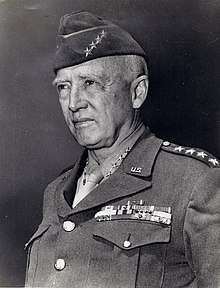 General George Patton, Jr., Two-time Distinguished Service Cross recipient
General George Patton, Jr., Two-time Distinguished Service Cross recipient Admiral Mark Ferguson III, 37th Vice Chief of Naval Operations
Admiral Mark Ferguson III, 37th Vice Chief of Naval Operations Brigadier General Theodore Roosevelt, Jr., Medal of Honor recipient
Brigadier General Theodore Roosevelt, Jr., Medal of Honor recipient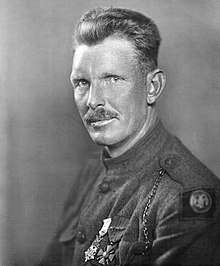 Sergeant Alvin York, Medal of Honor recipient
Sergeant Alvin York, Medal of Honor recipient Humphrey Bogart, Academy Award winner
Humphrey Bogart, Academy Award winner- Clark Gable, Academy Award winner
List of National Commanders
- Franklin D'Olier, Pennsylvania, 1919–1920
- Frederic W. Galbraith, Jr., Ohio, 1920–1921
- John G. Emery, Michigan, 1921
- Hanford MacNider, Iowa, 1921–1922
- Alvin M. Owsley, Texas, 1922–1923
- John R. Quinn, California, 1923–1924
- James A. Drain, Washington, 1924–1925
- John R. McQuigg, Ohio, 1925–1926
- Howard P. Savage, Illinois, 1926–1927
- Edward E. Spafford, New York, 1927–1928
- Paul V. McNutt, Indiana, 1928–1929
- O. L. Bodenhamer, Arkansas, 1929–1930
- Ralph T. O'Neil, Kansas, 1930–1931
- Henry L. Stevens, Jr., North Carolina, 1931–1932
- Louis A. Johnson, West Virginia, 1932–1933
- Edward A. Hayes, Illinois, 1933–1934
- Frank N. Belgrano, California, 1934–1935
- Ray Murphy, Iowa, 1935–1936
- Harry W. Colmery, Kansas, 1936–1937
- Daniel J. Doherty, Massachusetts, 1937–1938
- Stephen F. Chadwick, Washington, 1938–1939
- Raymond J. Kelly, Michigan, 1939–1940
- Milo J. Warner, Ohio, 1940–1941
- Lynn U. Stambaugh, North Dakota, 1941–1942
- Roane Waring, Tennessee, 1942–1943
- Warren H. Atherton, California, 1943–1944
- Edward N. Scheiberling, New York, 1944–1945
- John Stelle, Illinois, 1945–1946
- Paul H. Griffith, Pennsylvania, 1946–1947
- James F. O'Neill, New Hampshire, 1947–1948
- S. Perry Brown, Texas, 1948–1949
- George N. Craig, Indiana, 1949–1950
- Erle Cocke, Jr., Georgia, 1950–1951
- Donald R. Wilson, West Virginia, 1951–1952
- Lewis K. Gough, California, 1952–1953
- Arthur J. Connell, Connecticut, 1953–1954
- Seaborn P. Collins, New Mexico, 1954–1955
- J. Addington Wagner, Michigan, 1955–1956
- Dan Daniel, Virginia, 1956–1957
- John S. Gleason, Jr., Illinois, 1957–1958
- Preston J. Moore, Oklahoma, 1958–1959
- Martin B. McKneally, New York, 1959–1960
- William R. Burke, California, 1960–1961
- Charles L. Bacon, Missouri, 1961–1962
- James E. Powers, Georgia, 1962–1963
- Daniel F. Foley, Minnesota, 1963–1964
- Donald E. Johnson, Iowa, 1964–1965
- L. Eldon James, Virginia, 1965–1966
- John E. Davis, North Dakota, 1966–1967
- William E. Galbraith, Nebraska, 1967–1968
- William C. Doyle, New Jersey, 1968–1969
- J. Milton Patrick, Oklahoma, 1969–1970
- Alfred P. Chamie, California, 1970–1971
- John H. Geiger, Illinois, 1971–1972
- Joe L. Matthews, Texas, 1972–1973
- Robert E. L. Eaton, Maryland, 1972–1973
- James M. Wagonseller, Ohio, 1974–1975
- Harry G. Wiles, Kansas, 1975–1976
- William J. Rogers, Maine, 1976–1977
- Robert C. Smith, Louisiana, 1977–1978
- John M. Carey, Michigan, 1978–1979
- Frank I. Hamilton, Indiana, 1979–1980
- Michael J. Kogutek, New York, 1980–1981
- Jack W. Flynt, Texas, 1981–1982
- Al Keller, Jr., Illinois, 1982–1983
- Keith A. Kreul, Wisconsin, 1983–1984
- Clarence M. Bacon, Maryland, 1984–1985
- Dale L. Renaud, Iowa, 1985–1986
- James P. Dean, Mississippi, 1986–1987
- John P. Comer, Massachusetts, 1987–1988
- H. F. Gierke III, North Dakota, 1988–1989
- Miles S. Epling, West Virginia, 1989–1990
- Robert S. Turner, Georgia, 1990–1991
- Dominic D. DiFrancesco, Pennsylvania, 1991–1992
- Roger A. Munson, Ohio, 1992–1993
- Bruce Thiesen, California, 1993–1994
- William M. Detweiler, Louisiana, 1994–1995
- Daniel A. Ludwig, Minnesota, 1995–1996
- Joseph J. Frank, Missouri, 1996–1997
- Anthony G. Jordan, Maine, 1997–1998
- Harold L. Miller, Virginia, 1998–1999
- Alan G. Lance, Sr., Idaho, 1999–2000
- Ray G. Smith, North Carolina, 2000–2001
- Richard J. Santos, Maryland, 2001–2002
- Ronald F. Conley, Pennsylvania, 2002–2003
- John A. Brieden III, Texas, 2003–2004
- Thomas P. Cadmus, Michigan, 2004–2005
- Thomas L. Bock, Colorado, 2005–2006
- Paul A. Morin, Massachusetts, 2006–2007
- Martin F. Conatser, Illinois, 2007–2008
- David K. Rehbein, Iowa, 2008–2009
- Clarence E. Hill, Florida, 2009–2010
- Jimmie L. Foster, Alaska, 2010–2011
- Fang A. Wong, New York, 2011–2012
- James E. Koutz, Indiana, 2012–2013
- Daniel Dellinger, Virginia, 2013–2014
- Michael D. Helm, Nebraska, 2014–2015
- Dale Barnett, Georgia, 2015–2016
- Charles E. Schmidt, Oregon, 2016–2017
- Denise H. Rohan, Wisconsin, 2017–2018
- Brett P. Reistad, Virginia, 2018–2019
- James W. Oxford, North Carolina, 2019–2020
List of Honorary Commanders
- Marshal Ferdinand Foch[18]
- General John J. Pershing[18]
List of past National Commanders by vote of National Conventions
- Henry D. Lindsley, Texas, 1919
- Milton J. Foreman, Illinois, 1921
- Bennett Champ Clark, Missouri, 1926
- Theodore Roosevelt, Jr., New York, 1949
- Eric Fisher Wood, Pennsylvania, 1955
- Thomas W. Miller, Nevada, 1968
- Maurice Stember, New York, 1975
- Hamilton Fish III, New York, 1979
- E. Roy Stone, Jr., South Carolina, 1987
- Robert W. Spanogle, Michigan, 2008
See also
Notes
- Wheat 1919, pp. 14, 19, 206, 209
- "American Legion Day". The American Legion Magazine. Indianapolis, Indiana. September 2016. p. 8. ISSN 0886-1234.
- Burtin, Olivier (2020). "Veterans as a Social Movement: The American Legion, the First Hoover Commission, and the Making of the American Welfare State". Social Science History: 1–26. doi:10.1017/ssh.2020.5. ISSN 0145-5532.
- Wheat 1919, pp. v, vi
- Wheat 1919, p. 206-207
- Wheat 1919, p. 207-208
- American Legion: "Office Locations, accessed December 30, 2010
- Wheat 1919, p. 206
- National Constitution and By-laws. Indianapolis, Indiana: The American Legion National Headquarters. February 2016. p. 3.
- "11 key things to know about the LEGION Act". The American Legion. August 6, 2019. Retrieved August 8, 2019.
- "Membership in The American Legion". The American Legion Magazine. Indianapolis, IN. September 2016. p. 5. ISSN 0886-1234.
- The American Legion Weekly, OCLC 1480272. Master negative microfilm held by University Microfilms, now part of ProQuest.
- The American Legion Monthly, OCLC 1781656.
- American Legion Magazine, OCLC 1480271.
- Wheat 1919, p. 263
- Ford 1979, p. 62.
- Skeyhill 1930, pp. 290–291
- The American Legion Ninth Annual Convention: Official Program and Guide Book. Indianapolis, Ind.: The American Legion. 1927. p. 115 – via Internet Archive.
References
- “100th Anniversary Remembrance of Our Comrades in the 1919 Centralia tragedy” Publication of the Legion’s Americanism Commission.
- "American Legion 40th National Convention: official program [1958]". American Legion. 1958 – via Internet Archive. Cite magazine requires
|magazine=(help) - Ceplair, Larry (2011). Anti-communism in Twentieth-century America: A Critical History. Santa Barbara, CA: ABC-CLIO. ISBN 978-1440800474. OCLC 712115063.
- Ford, Gerald R. (1979). A Time To Heal: The Autobiography of Gerald R. Ford. New York: Harper & Row. ISBN 0060112972. OCLC 4835213.CS1 maint: ref=harv (link)
- Heale, M.J. (1990). American Anticommunism: Combating the Enemy Within, 1830–1970. Baltimore: Johns Hopkins University Press. ISBN 978-0801840500. OCLC 21483404.CS1 maint: ref=harv (link)
- Rumer, Thomas A. (1990). The American Legion: An Official History, 1919–1989. New York: M Evans & Co. ISBN 978-0871316226. OCLC 22207881.
- Skeyhill, Tom, ed. (1930). His Own Life Story And War Diary. Garden City, NY: Doubleday, Doran & Company. OCLC 317629283 – via Internet Archive.CS1 maint: ref=harv (link)
- Wheat, George Seay (1919). "The Story of The American Legion". The Birth of the Legion. New York and London: G. P. Putnam's Sons. LCCN 19012694. OL 7238700M – via Internet Archive.CS1 maint: ref=harv (link)

Further reading
- Littlewood, Thomas B. (2004). Soldiers Back Home: The American Legion in Illinois, 1919–1939. Carbondale: Southern Illinois University Press. ISBN 080932587X. OCLC 54461886.
- McFarland, Keith D. & Roll, David L. (2005). Louis Johnson and the Arming of America: The Roosevelt and Truman Years. Bloomington, IN: Indiana University Press. pp. 24–26. ISBN 978-0-253-34626-1. OCLC 1023102538. OL 22709936M.
- Moley, Raymond (1966). The American Legion Story. New York: Duell, Sloan and Pearce. ISBN 978-0809325870. OCLC 712139.
- Moorhead, Robert L. (1920). "Chapter XXI: The American Legion". The Story of the 139th Field Artillery, American Expeditionary Forces. The Bobbs-Merrill Company. pp. 179–182. OCLC 263171531 – via Internet Archive.
- Pencak, William (1989). For God & Country: The American Legion, 1919–1941. Boston: Northeastern University Press. ISBN 1555530508. OCLC 18682663.
- Spencer, Dewey, ed. (1979). History of The American Legion, Department of Arkansas, 1919–1979. Little Rock.
External links
- Official
- Official website

- American Legion on YouTube
- “100 Anniversary of the 1919 Centralia tragedy”
- "National Constitution and By-Laws of The American Legion" as amended through September 3, 2015.
- General information
- American Legion at the Encyclopædia Britannica
- American Legion, Dept. of Washington records, 1919–1920 at the University of Washington Libraries
- "American Legion photographs". University of Missouri–St. Louis.
- American Legion politician members at The Political Graveyard
- The American Legion at The Online Books Page
- United States of America Vietnam War Commemoration at the Department of Defense Vietnam War Commemoration Program Office
- Works by or about American Legion at Internet Archive
- World War I Centennial Commission at the United States Foundation for the Commemoration of the World Wars